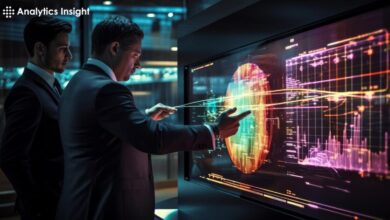The Role of Data Science in Modern Election Campaigns

As India prepares to go to the polls for the next round of the country’s democratic exercise, the Lok Sabha election, data scientists and data engineering are playing an increasingly important role in the formulation of campaigns, understanding of voters’ sentiments, and the optimization of political strategies.
In a country as diverse and large as India, the use of data can have a major impact on the outcome of the election. Data scientists play a key role in modern political campaigns, as they can analyze large amounts of data through the use of advanced analytics and machine learning algorithms as well as big data technologies.
The Role of Data Science in Modern Election
There are many ways that the role of data science in modern election is taking up the political campaigns. Let’s look at some of the most important areas where it can be used:
Voter Profiling & Targeting
Data scientists can use demographic, socio-economic, and behavioral information to create detailed profiles of voters. They can use this information to identify swing voters and tailor messages to those specific demographics to maximize the impact of the campaign.
Predictive Modeling
Data scientists use historical data and current inputs to create predictive models that can be used to predict election outcomes at a local level. They can use these models to take into account things like demographic changes, economic trends, and public opinion.
Campaign Optimization
Data engineers are essential for the collection, storage, and processing of large amounts of data during a political campaign. Hence, this is another role of data science in modern elections that is attributed to building strong data infrastructure and deploying scalable solutions; campaign managers track how voters are engaging with the campaign, measure the effectiveness of the campaign strategies, and make real-time decisions based on the data.
Opinion Analysis
Data analysis can help political parties understand public opinion and sentiment on social media platforms. Data scientists can use NLP techniques to look at social media conversations, identify trends, and measure how voters feel about particular candidates or issues. With this knowledge, parties can adjust their messaging and react quickly to changes in public opinion.
Directed Messaging and Outreach
With data-driven insights, parties can tailor their communication strategies to reach different types of voters. They can deliver targeted messages through email, SMS, social media, and other channels to reach voters and get them to support their candidates.
Resource Distribution
Using data-driven insights can help parties allocate campaign resources more efficiently. They can identify key battlegrounds and allocate resources to those areas where they have the best chance of success. This will help them maximize their campaign budgets and the impact they can have on the election.
Election Monitoring and Fraud Detection
Data analytics can also be used to monitor elections and detect irregularities, such as fraud or manipulation of votes. Data scientists can analyze voting behavior and discrepancies in turnout to identify areas of interest and detect instances of electoral misconduct.
The Advantages of Using Data Science in Modern Election
Better audience segmentation: With data science, campaigns can segment the electorate based on different demographic and behavioral characteristics. This allows them to tailor messages to the needs of different groups of voters.
Message tailoring: Data science gives campaigns a deeper understanding of voters’ preferences, allowing them to tailor their messaging to specific issues that appeal to different segments. This personalized approach increases engagement and the likelihood of converting voters.
Mobilization strategies: Data science helps campaigns identify potential supporters or undecided voters, so they can focus their efforts on targeting those individuals. Knowing what motivates each group to vote and engaging them can help campaigns optimize their mobilization efforts and increase their chances of getting more voters to the polls.
Real-time feedback loop: With data from different sources, campaigns can get feedback on how effective their messaging strategies are in real-time. This feedback loop allows them to continuously improve and adjust their messaging to ensure it remains relevant and effective.
The Importance of Big Data in Predicting Election Outcomes
Big data is the vast amount of data collected from various sources over the past few years. From social media to online platforms to surveys, data scientists have access to a wealth of information. This data can be used to gain a better understanding of voters’ preferences, opinions and sentiments. With sentiment analysis, analysts can get a better understanding of how people feel about a particular candidate or policy. This information can be used to predict public opinion and ultimately the outcome of an election.
Big data gives data scientists the ability to analyze large amounts of information collected from various sources. This includes social media and online platforms. Sentiment analysis techniques can be used to get an idea of how people are feeling on social media and to predict how people will vote.
1. Historical election data can be used to identify key factors that affect swing voters, such as demographics, socio-economic status, and past voting patterns. These models can be used to predict how swing voters will vote. This allows political campaigns to target swing voters with messages and policy proposals that resonate with them.
Data science can help you identify and target swing voters, who make up a significant portion of the electorate. By looking at historical election data and identifying key factors, you can create models to predict swing voters’ behavior.
2. Machine learning can also be used to create predictive models that can be used to identify potential cases of fraud. Machine learning models can be used to learn from past data and patterns and can be used to detect anomalies and flag up suspicious activities.
Data science is a powerful tool for preserving trust in our democratic process and protecting the integrity of our elections. Data science helps in the detection and prevention of voter fraud by analyzing voting patterns and related data. Machine learning can be used to build predictive models that use machine learning algorithms to detect potential cases of fraud, which can be used to ensure election integrity.
Conclusion
To sum up, data science plays an essential role in predicting how voters will vote and how the election will be won or lost. By analyzing large amounts of data, recognizing swing voters, dealing with fraud, and taking advantage of future technological advances, the data scientists and the political analysts are able to make informed decisions that add a data-based element to our democracy. As we use data science more and more, we are moving towards a better and more informed democracy.



